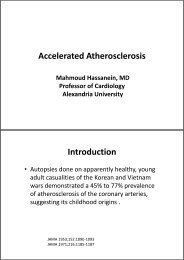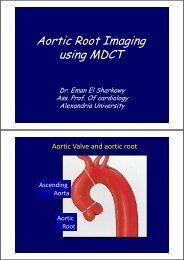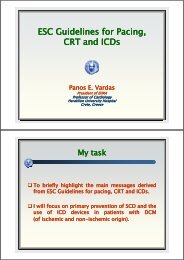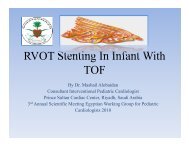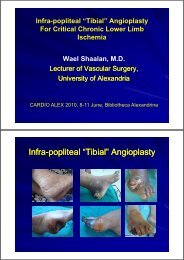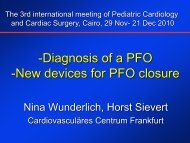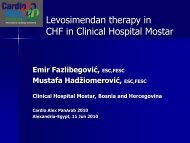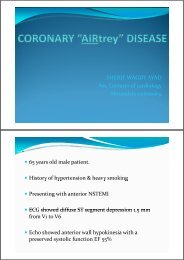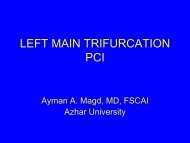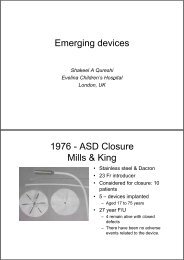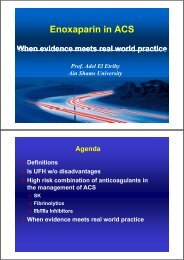Perimembranous VSD
Perimembranous VSD
Perimembranous VSD
Create successful ePaper yourself
Turn your PDF publications into a flip-book with our unique Google optimized e-Paper software.
Incidence of isolatedventricular septal defects• Most common congenital heartdisease (CHD) (20% of all CHD)• 80% → perimembranous <strong>VSD</strong>(pm <strong>VSD</strong>)
Indications for surgical<strong>VSD</strong> Closure• Relevant shunt:- Qp/Qs > 2 : 1 and LV volume overload- Qp/Qs > 1.5 : 1* and• PA pressure < 2/3 of systemic pressure andPVR < 2/3 of systemic Vascular resistance- Qp/Qs > 1.5 : 1 and• LV systolic or diastolic failure• History of endocarditis*CCS Guidelines 2006, AHA Guidelines 2008
Exclusion criteria forpercutanous <strong>VSD</strong> closure• Overriding aorta• Supracristal <strong>VSD</strong>• Associated significant aortic regurgitation• Prolapse of aortic cusp• Sub-aortic stenosis• Sub-pulmonary stenosis• Eisenmenger syndrome
Signs for small <strong>VSD</strong>Many <strong>VSD</strong> are small and do not require closure• Echo:- Asymptomatic- High velocity jet through <strong>VSD</strong>- No LV volume overload- No pulmonary hypertension• Catheterization:- Qp:Qs < 1.5- Mean pulmonary artery pressure < 25 mmHg- Low PVR < 200 dyn.s.cm -5
Exclusion criteria forpercutaneous <strong>VSD</strong> closureoverriding aortaprolapse of aortic cusp
Exclusion criteria forpercutaneous <strong>VSD</strong> closureEisenmenger syndromeRV RVCourtesy: Neil Wilson,TEE 0˚
<strong>VSD</strong>-Closure Devices• Clamshell, Cardioseal-/Cardioseal-Starflex– ~ 300 patientsJ Lock, Boston
Amplatzer Closure Devices• ASD (4-36 mm)• <strong>VSD</strong> (4-18 mm)• Post-MI <strong>VSD</strong> (16-24 mm)• Perimembraneous <strong>VSD</strong>
<strong>Perimembranous</strong> <strong>VSD</strong>Close proximity to tricuspid and aortic valveas well as to conduction system
<strong>Perimembranous</strong> <strong>VSD</strong>Echo evaluation• Size (Measurements in different planes)• Number (single/multiple)• Anatomy of funnel (aneurysmal orserpiginous defects?)• Rim to aortic valve?• Associated defects (ASD/ pulmonarystenosis/aortic coarctation/…)• Contra-indications to percutaneous closure
<strong>Perimembranous</strong> <strong>VSD</strong>Echo evaluation• TTE views- Parasternal LAX and SAX views- Apical 4 and 5 chamber views- Subcostal views
<strong>Perimembranous</strong> <strong>VSD</strong>Echo evaluation• TEE views- Mid- esophageal 4 and 5 chamber views (0˚)- Mid-esophageal LAX view (130 ˚)- Mid- low esophageal SAX view (30-35 ˚)
<strong>Perimembranous</strong> <strong>VSD</strong>TTE LAX view
<strong>Perimembranous</strong> <strong>VSD</strong>TTE LAX view (zoom)Measurement: 8mm
<strong>Perimembranous</strong> <strong>VSD</strong>TTE SAX view
<strong>Perimembranous</strong> <strong>VSD</strong>TTE 4/5 chamber view
<strong>Perimembranous</strong> <strong>VSD</strong>TTE subcostal view
<strong>Perimembranous</strong> <strong>VSD</strong>TEE 4 Chamber view (0˚)
<strong>Perimembranous</strong> <strong>VSD</strong>Detailed assessment•Aneurysm?• How many defects?•Diameter of*infundibulum•Rim to aortic valve
<strong>Perimembranous</strong> <strong>VSD</strong>TEE LAX- wire through <strong>VSD</strong>
Additional defects?
<strong>Perimembranous</strong> <strong>VSD</strong>• Sometimes it is difficult to analyzethe margins and measure the size• Measurements in 2D and+ colourdoppler• Evaluation with 3D if available
Muscular <strong>VSD</strong>Echo evaluation• Size (measurements in different planes)• Number (single/multiple)• Location (apical, mid-muscular/highmuscular)• Associated defects (ASD/pulmonarystenosis/aortic coarctation/…)• Contra-indications for closure?
Muscular <strong>VSD</strong>• TTE viewsEcho evaluation- Apical 4 chamber view- Parasternal LAX and SAX views- Subcostal views
Muscular <strong>VSD</strong>• TEE viewsEcho evaluation- Mid-esophageal 4 chamber view (0˚)- Trans- gastric views- Mid-esophageal SAX views(30-35˚)
Muscular <strong>VSD</strong>2D TEE in 0 ˚ and 90 ˚
Muscular <strong>VSD</strong>2D TEE + colour: 4 Chamber view 0˚
Muscular <strong>VSD</strong>Aspect of <strong>VSD</strong> →from LV and RV side
Muscular <strong>VSD</strong>3D TEE full volume: LV aspect of mid- muscular <strong>VSD</strong> + colour
Muscular <strong>VSD</strong>Mid-muscular <strong>VSD</strong> after closure
Case44 y old man• Pre-diagnosed muscular <strong>VSD</strong>-Measurements: 6mm• 11/2010 implantation of a 6mmmuscular <strong>VSD</strong> occluder
Case44 y old manSizing: 14x8mmMigration of device→ size carefully!
Muscular <strong>VSD</strong>Echo evaluation• Usually easy to analyze the marginsand measure the size of the defect• Measurements of the defect in 2D andwith colour doppler• Measurements with 3D if available
Post Myocardial Infarction<strong>VSD</strong>s
Acute Ventricular Septal Rupture• Medical treatment is difficult- 50-70% mortality within the first week- less than 10% survive month 1-3• Standard of therapy is surgery- Hospital mortality 10 to 60%- <strong>VSD</strong> re-occurs in 10-20%• Patch dehiscence• Development of a new <strong>VSD</strong>• Overlooked second <strong>VSD</strong>
Specific problems in post-MI <strong>VSD</strong>‘s• Atypical locations, deficient rim• Multiple defects• Large defects need immediatetreatment• Tissue weakening up to 2 w. post MI‣ We have the same problem as the surgeons‣Need for early treatment‣Better results with delayed treatment
Imaging in post- MI <strong>VSD</strong>s• Can be difficult→ unstable patient• TTE: poor imaging quality• TEE: inadequate alignment• Antero-apical defects difficult• MRI?
CaseInferior PI <strong>VSD</strong>• 82 y old man• Inferior MI 1998 + surgical <strong>VSD</strong> closure(patch, aneurysm resection)• EF 40%• 2005: large <strong>VSD</strong> (inferior location)• PAPs 70mmHg• Dyspnea Nyha III-IV• Qp:Qs 2.2• 1.9.2010- percutaneous <strong>VSD</strong> closure
CaseInferior PI- <strong>VSD</strong>20 mm Amplatzer ASD occluder- captured by trabeculae
CaseInferior PI <strong>VSD</strong>• 6/2010 (external evaluation):• Qp:Qs 1.16• Mild residual shunt adjacent to occluder• EF: 50%• PAPs 35 mmHg• Dyspnea Nyha II
Strategy in PI <strong>VSD</strong>s• Early treatment !!• Oversized devices (50-100%)
Take home message• Echocardiographic evaluation is mandatory inpatients with <strong>VSD</strong> for patient selection ( useof all imaging modalities)• Good imaging is crucial for planning ofintervention• Combined Echo and angio evaluation decideabout the closure technique and properdevice selection
Thank You
Percutaneous <strong>VSD</strong> closureComplications• Complete A-V block• Aortic and Tricuspid valve dysfunction• Malposition of device• Residual defectCarminati M et al.European H J 2007, 28: 2361Kenny D et al: Catheter Cardiovasc Interv 2009, 73:568-75
Adverse events after device closure ofperimembranous <strong>VSD</strong>s (n = 100 procedures)Holzer et al., Catheterization and Cardiovascular Interventions 2006; 68: 620-628
Carminati et al, CSI 2005, FrankfurtPost MI- <strong>VSD</strong>s (n=43)European <strong>VSD</strong> Registry• Reasons for in-hospital death- Multiorgan failure 15- Device embolisation 2- Tamponade 2- Leg ischemia 1- Tricuspid valve injury 1
Catheter Closure of Post MI <strong>VSD</strong>snSuccess(%)Mortality(%)Chessa 2002 12 83 40Szkulnik 2003 7 71 20Goldstein 2004 4 75 25Holzer 2004 18 89 39Martinez 2007 5 100 20Ahmed 2007 5 4 40
Post-infarction <strong>VSD</strong>• 80% die within 4 weeks• 90% die within 6 month→ All need closure(surgical or percutaneous)
European <strong>VSD</strong> Register430 attempts in congenital <strong>VSD</strong>s, 409 devices implanted> 14 yrs34%
• Procedural mortality lowest it you waituntil tissues have healed (~ 3 weeks)• … but then > 90% of the patients havedied• → do it as soon as possible
Transcatheter closure ofperimembranous <strong>VSD</strong>Year Author N age (years) weight (kg)2006 Y.-C. Fu 35 median 7.7 median 25(1.2 – 54.4) (8.3 – 110)2006 R. Holzer 100 median 9 median 27.5(0.7 – 58) (7 – 121)2006 R. Pinto 20 median 10 median 32(7 – 21)2005 I. Masura 186 median 15.9 median 43(3 – 51) (12.5 – 77)not published T. Lê 86 mean 16.2 mean 32( Pfm coil ) (3 – 57) (12 – 71)
Surgical closure of <strong>VSD</strong> in 2079 patientsat GOH, London, from 1976 to 2001open columns = isolated <strong>VSD</strong>shaded columns = TOFAndersen et al., Ann Thorac Surg 2006; 82: 948-57
Transcatheter closure of pm <strong>VSD</strong> :amount of L-R shuntBeekmann, J Pediatr 2007; 150: 569-570
Incidence of complete heart block (CHB) andmortality after surgical closure of isolated <strong>VSD</strong>Year Author surgical period N CHB Mortality2001 Gaynor 1996 – 1999 172 0% 0.6%2003 Bol-Raap 1992 – 2001 188 1% 2%2006 Andersen 1976 – 2001 996 0.7% 1.5%
European Registry on Transcatheter <strong>VSD</strong> Closure<strong>Perimembranous</strong> <strong>VSD</strong> ( n= 250 ) and CompleteHeart Block 13 (5%)4 (1.4%) Transient2 device implanted2 surgical device removal9 (3.6%) Permanent5 early (within 1 week)4 late (4-18 months)Courtesy Mario Carminati
Central Cardiac Audit Database in UK:Interventional closure ofperimembranous <strong>VSD</strong>Number504540353025201510505 32000-20012001-200282002-2003452003-20042004-20052005-2006J Gibbs personal communication in: Sullivan et al., Heart 2007; 93: 284-286234
Andersen et al., Ann Thorac Surg 2006; 82: 948-57
Spontaneous <strong>VSD</strong> closureExponential decay curve of rate of closureKrovetz et al., Am J Cardiol 1998; 81: 100-101
Long-term outcome of adult patients (mean 30 y)with <strong>VSD</strong> considered not to require surgicalclosure during childhood• 118 prospectively followed pts• Study entry: 1993 - 1996• Events: death, endocarditis or surgery• Spontaneous closure in 6%Gabriel et al., JACC 2002; 39: 1066-71
Device Closure of<strong>Perimembranous</strong> <strong>VSD</strong>Follow Up After Device Closure of <strong>Perimembranous</strong> <strong>VSD</strong>sHolzer et al., Catheterization and Cardiovascular Interventions 2006; 68: 620-628
European Registry on Transcatheter <strong>VSD</strong> ClosureComplete AV Block and <strong>Perimembranous</strong> <strong>VSD</strong>(Stepwise logistic regression analysis)%15%105< 5 y6-15 y> 15 y0cAVBCortesy Mario Carminati,
Surgery (post infarction• Disapointing<strong>VSD</strong>)• Early- tissues friable, patient unstable• Late (>3 weeks)tissues stronger,remodelling• Inferior location worse than anterior
<strong>Perimembranous</strong> <strong>VSD</strong>
<strong>VSD</strong>
European <strong>VSD</strong> Register430 attempts in congenital <strong>VSD</strong>s, 409 devices implanted• Perimembraneous 250• Muscular 119• Multiple 27• Residual post surgery 45
European <strong>VSD</strong> RegisterDevices implantedASD Amplatzer2%Starflex2%Coil2%2 devices4%PDA Amplatzer3%MembraneousAmplatzer51%MuscularAmplatzer36%Technical Success Rate 95 %
European <strong>VSD</strong> Register-430 attempts, 409 devices implanted(250 perimembr.,119 muscular,16 multiple congenital <strong>VSD</strong>)• Occluder Embolisation 5- Surgery (2), catheter retrieval (3)• Aortic valve insufficiency 14- Need for surgery (12)• Tricuspid valve insufficiency 27- No need for treatment• Transient or mild arrhythmia 102° AV block (1), LBBB (2), RBBB (3)• Complete AV-Block 17
Carminati et al, CSI 2005, FrankfurtPost MI- <strong>VSD</strong>s (n=43)European <strong>VSD</strong> Registry• Age 65 yrs (52-86)• <strong>VSD</strong> diameter 14 mm (6-24)• Acute phase 30• Non acute phase or post surgery 13• In hospital mortality- Acute phase 15/30 50%- Non acute phase 3/13 23%
Most frequently used devicesAmplatzer devices• ASD (4-36 mm)• <strong>VSD</strong> (4-18 mm)• Post-MI <strong>VSD</strong> (16-24 mm)
Most frequently used devicesperimembranous Amplatzer <strong>VSD</strong> occluder



